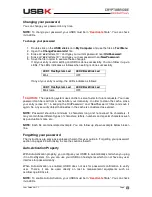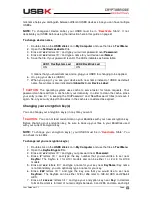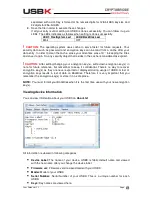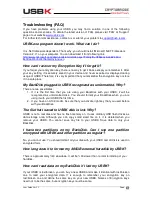
User Guide Ver:1.1 Page:
32
To deactivate your USBK:
#usbk -u DEVICENAME -d
NOTE:
if you execute the command to get more detail information, you will see the status of
USBK as deactivate.
!
CAUTION:
Before deactivating USBK, you must be sure that the disks of BackDisk are
unmount ; otherwise deactivation without unmounting could corrupt the data on the devices.
Usage of BackDisk
Once you activate your USBK, you can save files to your BackDisk same as regular usage of
ordinary USB sticks. USBK encrypts data transferred to/from your BackDisk using the AES
algorithm (FIPS PUB 197). Data is automatically decrypted when you open the file.
Data can be copied to/from a mounted BackDisk at back of USBK just like they are copied
to/from any normal USB drive.
NOTE:
To access to your BackDisk, the status of your USBK must be “
Activate
”. If it is
“
Deactivate
” and you can not access your BackDisk.
!
CAUTION:
Any person, any application or software that use the open platform of computer
can access the BackDisk and become a user when USBK is in “
Activate
” state
!
CAUTION:
If you leave your USBK plugged-on your computer in “
Activate
” state, any user
can access your data on your BackDisk while you are away from the computer.
Changing your password
You can change your password in any time when the status of USBK is “
Deactivate
”
To change your password
Below command is used to change password:
#
usbk -u DEVICENAME -p PASSWORD -c NEWPASSWORD
NOTE:
Password should be minimum 4 characters long and not exceed 16 characters. It
may contain three different types of characters: letters, numbers and special characters such
as punctuation marks, etc
Forgetting your password
The instructions are same as expressed herein this user guide in ‘Forgetting your password’
section on pages 23 with taking in care the cautions therein.
Auto-Activation Property
With Auto-Activation property, you configure your USBK to automatically start when you plug
it in a HostSystem. So, you can use your USBK on HostSytems which do not have any user
interface for password entry.















































